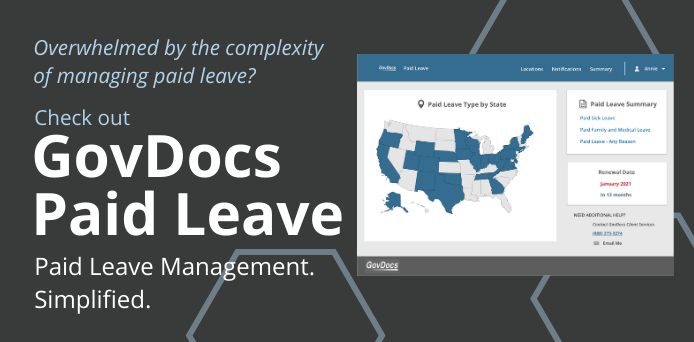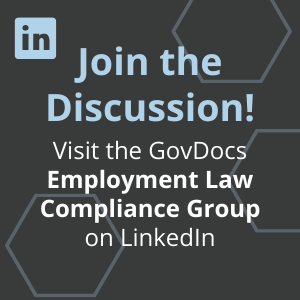EMPLOYMENT LAW NEWS
New Minnesota Paid Sick Leave Law
By Jana Bjorklund, GovDocs Senior Counsel and Director, Employment Law and Compliance
Published June 1, 2023

In light of the new Minnesota paid sick leave law, employers should review their leave policies to ensure it meets the requirements, plan for any changes that need to be made to comply with the law, prepare for the wage statement requirements and determine approach for notice requirements to all employees.
A Minnesota paid sick leave law was signed by the governor in late May 2023.
The statewide Minnesota Earned Sick and Safe Leave (ESSL) law will provide covered employees with up to 48 hours of paid leave per year. The time can be taken for various reasons, including when the employee is sick, to care for a sick family member, or seek assistance if they or a family member experienced domestic abuse.
The new Minnesota paid sick leave law goes into effect Jan. 1, 2024. (UPDATE, June 2023: An associated labor law poster has been released.)
(Also, keep an eye on Employment Law News for a blog on Minnesota’s new paid family and medical leave law.)
Paid Leave Management. Simplified.
Minnesota Paid Sick Leave
Gov. Tim Walz signed the bill into law May 24, 2023.
Below are some of the specifics of the Minnesota paid sick leave law.
Who is a Covered Employer?
Essentially any individual or business with one or more employees in Minnesota must provide earned sick and safe leave to its employees.
Temporary employees supplied to an employer by a staffing agency are considered employees of the staffing agency.
Who is a Covered Employee?
Employees are covered if they work at least 80 hours in a year for a Minnesota employer.
The law covers part-time and temporary employees but excludes independent contractors, individuals employed by an air carrier as a flight deck or cabin crew member, or an employee who works less than a majority of their hours in Minnesota in a calendar year.
Definition of Family Member
Under the Minnesota paid sick leave law, the definition of family member for whom the employee may take ESSL is extremely broad. It includes the following:
- The employee’s child, foster child, adult child, legal ward, child for whom the employee is legal guardian, or a child to whom the employee stands in loco parentis
- The employee’s spouse or registered domestic partner
- The employee’s sibling, stepsibling, or foster sibling
- The employee’s biological, adoptive, or foster parent, stepparent, or a person who stood in loco parentis when the employee was a minor child
- The employee’s grandchild, foster grandchild or step-grandchild
- The employee’s grandparent or step-grandparent
- A child of the sibling of the employee
- A sibling of the employee’s parents
- A child-in-law or sibling-in-law
- Any family members of the employee’s spouse or registered domestic partner
- Any individual related by blood or whose close association with the employee is the equivalent of a family relationship
- Up to one individual annually designated by the employee
Eligible Reasons for Sick and Safe Leave
Meanwhile, ESSL may be used for any of the following reasons:
- The employee’s mental or physical illness, injury, or other health condition, need for medical diagnosis, care, or treatment of a mental or physical illness, injury or health condition, or preventive medical or health care
- Care of a family member with a mental or physical illness, injury, or other health condition, medical or who needs medical diagnosis, care, or treatment of a mental or physical illness, injury, or other health condition, preventive medical or health care
- Absence related to employee’s or family member’s need to seek medical attention related to physical or psychological injury or disability caused by domestic abuse, sexual assault, or stalking. This includes seeking relocation, taking steps to secure an existing home due to domestic abuse, seeking legal advise or taking legal action resulting from domestic abuse, sexual assault, or stalking, obtaining services from a victim services organization, and obtaining psychological or other counselling
- Closure of the employee’s place of business due to weather or other public emergency or an employee’s need to care for a family member whose school or place of care has been closed due to weather or other public emergency
- The employee’s inability to work or telework because the employer prohibits work because of health concerns related to the potential transmission of a communicable illness related to a public emergency, or employee is seeking or awaiting the results of a diagnostic test for, or a medical diagnosis of, a communicable disease or the employee’s employer has requested a test or diagnosis
- When it is determined by the health authorities having jurisdiction or by a health care professional that the presence of the employee or family member of the employee in the community would jeopardize the health of others because of the exposure of the employee or family member of the employee to a communicable disease, whether or not the employee or family member has actually contracted the communicable disease
Accrual Rate, Carryover, and Frontloading
Under the Minnesota paid sick leave law, employees must accrue one hour of ESSL for every 30 hours worked up to a maximum of 48 hours of ESSL in a year.
Employees may not accrue more than this amount in a year unless agreed to a higher amount by the employer. Employees must be allowed to carry over accrued but unused ESSL into the following year, which may be capped by the employer at a total of 80 hours.
In lieu of permitting the carryover of accrued but unused ESSL, an employer may frontload ESSL by providing an employee with ESSL that meets or exceeds the amounts under the law at the beginning of the year. How much ESSL is frontloaded will depend on whether the employer will be paying the employee for any accrued but unused ESSL at year end.
If an employer frontloads 48 hours at the beginning of each year, the employer must pay the employee for any accrued but unused ESSL. If an employer frontloads 80 hours at the beginning of each year to its employees, then the employer is not required to pay employees for accrued but unused ESSL at year end.
Effect on Other Paid Sick Leave Laws in Minnesota Cities
Minnesota’s ESSL law does not preempt any other paid sick leave laws passed by cities in Minnesota with greater benefits.
There are four cities in Minnesota with their own paid sick leave laws that employers will need to coordinate with the new ESSL state-wide requirements to ensure they are providing the greater benefits. Those cities are:
- Bloomington (effective July 1, 2023
- Duluth
- Minneapolis
- St. Paul
Notice and Posting Requirements
The amount of earned ESSL accrued and available for use along with the total number of used ESSL during a pay period will need to be included in the employees’ earning statements or provided in writing by electronic means covering each pay period.
Employers will also be required to provide employees with notice of their ESSL rights at the start of employment or on Jan. 1, 2024, whichever is later. The notice must be in English and the primary language of the employee, as identified by the employee. Employers may satisfy the notice requirement by posting the notice in each work location in a conspicuous place frequented by all employees, by providing a paper or electronic notice to employees, or posting the notice on a web-based or app-based platform through which the employees perform work.
Employers who maintain employee handbooks must include a notice in their handbook of the employees’ rights and remedies under the ESSL.
Get More Out of Your Labor Law Poster Program
Next Steps for Minnesota Paid Sick Leave
In light of the new Minnesota paid sick leave law, employers should review their leave policies to ensure it meets the ESSL requirements, plan for any changes that need to be made to comply with ESSL, prepare for the wage statement requirements and determine approach for notice requirements to all employees.
This Employment Law News blog is intended for market awareness only, it is not to be used for legal advice or counsel.
Keep Informed
with GovDocs Employment Law News
Who is GovDocs?
GovDocs simplifies employment law compliance for large employers in the U.S. and Canada. The GovDocs software platform integrates three solutions in one convenient place to help you master the employment laws impacting your business. Whether you manage a labor law posters, minimum wage or paid leave program, our products cut through research time, provide proactive insights into the everchanging landscape of employment laws and reduce the risk of noncompliance. The company is headquartered in Eagan, Minn.
The GovDocs Poster Store simplifies posting compliance for employers with less than 30 locations across all industries, offering a variety of posting products to meet your labor law compliance needs.





